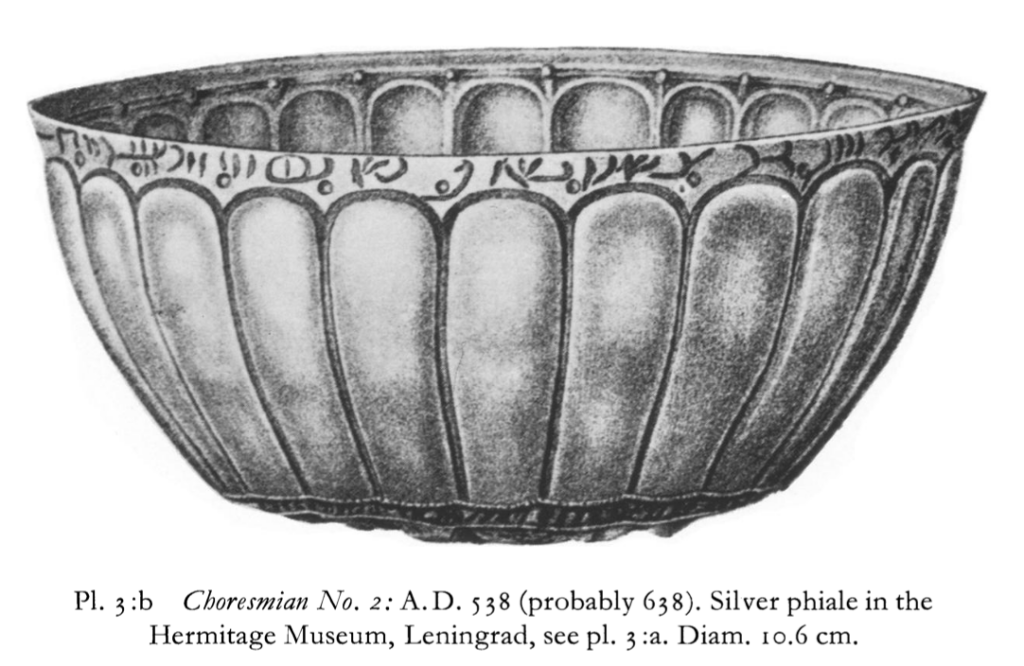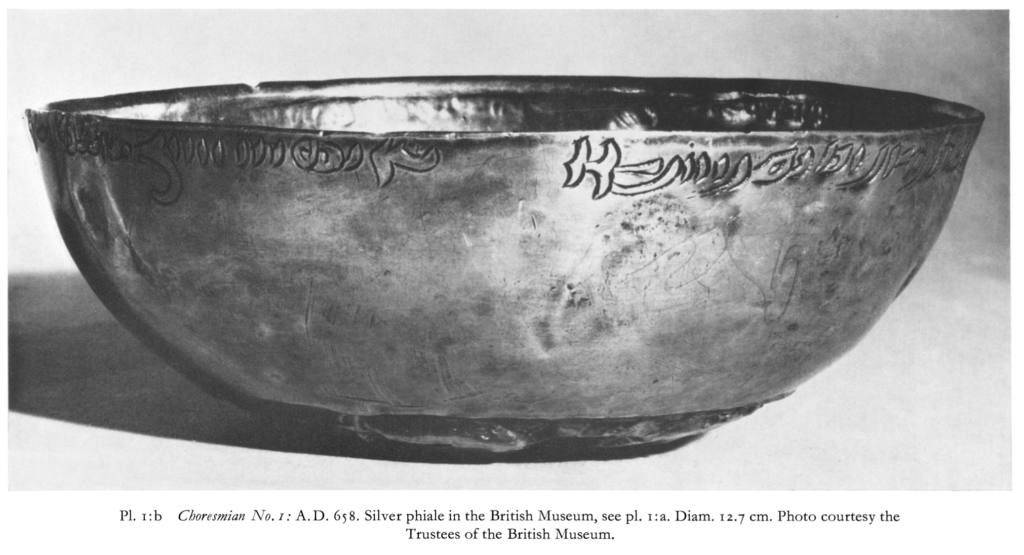A number of silver vessels bearing inscriptions in Middle Chorasmian have been found in various locations in the Ural mountains (the Perm region, to be specific) far from Chorasmia. This fact is likely indicative of the northward trade connections of Chorasmia in the medieval period on.

The imagery and craftsmanship of these objects was analyzed in some detail by Azarpay (1969), with some depictions but no decipherment of the inscriptions, who argued that the inscriptions and designs were all contemporaneous. Her conclusions are of significant interest:
Thematic and stylistic analysis of the nine Choresmian silver dishes indicates the presence in the Oxus delta region of distinctive metalworking workshops during the early Medieval period (A.D. VII-VIII century) with roots in the late Antique tradition of Choresm, which had been interrupted in the fourth century. The absence of a pronounced Sassanian influence, and the iconographic links between Choresmian art and the traditions of the southern Central Asian states in Transoxiana and Bactria, seem to reinforce the emerging image of Choresm as an independent early Medieval state with cultural affinities with the ancient Iranian traditions of eastern Iran and Central Asia. An active commercial policy, perhaps reinforced by the strategic position of Choresm as a frontier state between the urban civilizations of Iran and Transoxiana and the northern steppe belt, would seem to explain how the majority of the Choresmian inscribed dishes came to be found not in Choresmian territory but in the vicinity of Perm and the Kama river basin in the Ural mountains. (Azarpay 1969:203)
About half of the silver objects bear dates in the (or a) Chorasmian era; though the exact chronology of the Chorasmia era is still uncertain, the dates which could be deciphered were argued by Livshits and Lukonin (1964) to correspond to around the 6th-7th centuries CE. On paleographical grounds, the undated inscriptions are attributed to a similar time period.
The majority of the inscriptions are still undeciphered. Until recently, only sporadic comments in scattered, older Russian publications provided some information on possible readings. Five of the inscriptions have now been tentatively deciphered and analyzed by Lurje (2018) with insightful comments on the script and the dating.
| Num. | Findspot/Current Location | Date | Inscription |
| 1 | —/Hermitage Museum | 700 Chor. | |
| 2 | Perm (1845-6)/Hermitage Museum | 5/670 Chor. | Lurje 2018 |
| 3 | —/Hermitage Museum | Lurje 2018 | |
| 4 | Perm (1875)/Perm Regional Museum | ||
| 5 | Perm (1875)/Hermitage Museum | Lurje 2018 | |
| 6 | Mal’tsevo (1878)/Hermitage Museum | 7/8th cent. CE | Lurje 2018 |
| 7 | Perm (1889)/Hermitage Museum | Lurje 2018 | |
| 8 | — (before 1908)/present location unknown | ||
| 9 | —/State Museum Moscow | > 723 Chor. | |
| 10 | —/Hermitage Museum | 714 Chor. | |
| 11 | —/Hermitage Museum | 720 Chor. |

Much further study of the objects’ histories and of the remaining undeciphered inscriptions is necessary.
Bader, O.N. & A.P. Smirnov. 1954. ‘Серебро’ закамское первых веков нашей эры. Бартымское местонахождение. Moscow.
Livshits, V.A. & V.G. Lukonin. 1964. Srednepersidskie i sogdijskie nadpisi na serebrianykh sosudakh. Vestnik drevnei istorii 3.
